What can you use instead of plastic wrap?
A question that keeps coming up is, what are plastic cling wrap alternatives? And how do you pack lunches or store food without plastic wraps?
The good news is, there are many eco-friendly and zero waste alternatives to disposable plastic wraps. Many of them aren’t new, which makes it easy to ditch these single-use plastics. To help you get started, I’ve listed a range of options to help you replace cling wraps.
And because it’s a question that gets asked, I’ve also included information about health concerns, particularly when it’s heated. And for those that are curious, a brief history about how cling wrap came to exist.
Use the clickable table of contents, to jump to where you want to start.
- The history of plastic cling wraps
- What are the health concerns with cling wrap?
- Can cling wrap be recycled?
- Cling wrap alternatives
For information on hosting a Plastic Free Workshop in Melbourne or online, get in touch.
The history of plastic cling wraps
You could say the creation of plastic wrap began by chance, in the Dow Chemical labs, in America, in 1933. A lab assistant, Ralph Wiley, was having trouble washing out glassware from experiments when trying to create a dry-cleaning agent, as there was a thin film that was difficult to remove.
This discovery was a plastic polymer, now known as polyvinylidene chloride. Researchers saw potential in this plastic, so did experimentation with it. They discovered that it offered protection from moisture and corrosive chemicals, and resistance to oils and greases. It was developed for military use as protective spray for aircraft and other equipment.
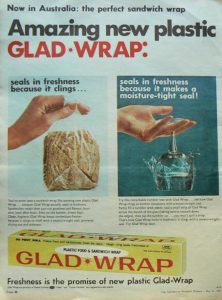
This plastic was further developed and released for commercial use in 1949, as a plastic cling film. The first cling wrap for household use was released in 1952, as Saran Wrap.
Glad Wrap was invented in Sydney, in the Union Carbide labs by a research chemist, Douglas Lyons Ford. While it looked the same as Saran Wrap, Glad Wrap was a different composition, as it is made from polyethylene. Glad Wrap made its first retail appearance in 1963, in America, as a competitor to Saran Wrap.
In 1966 both Glad Wrap and the resealable plastic Glad Bags, also known as snap locks were launched in Australia.
Since then many other brands have come on the market, and the plastic wrap market in Australia alone is now valued at $51 million.
If the story of plastic interests you, or if you want more about how about how these plastics became a part of life, you can get your plastic history geek on with how plastic wrap is made.
For more about how Glad Wrap came to be in Australia, check out the Australian Food Timeline.
What are the health concerns with cling wrap?
Cling wraps can be made out of different types of plastics such as polyvinylidene chloride (PVDC), polyvinyl chloride (PVC) or polyethylene. To make the plastic soft and flexible, chemical additives such as plasticizers are used, particularly with PVC cling film.
Studies indicate that some of the chemicals used in these plastics could pose health concerns, because they can leach out of the plastic and into the food. Some of these chemicals have been linked to health problems such as reduced fertility, metabolic disorders (obesity) and cancers and other conditions. This leaching is most problematic, when heated.
So it’s recommended that cling wrap doesn’t touch food during microwaving. This makes me question if it should be used in the microwave at all? Here is more on the safety of food packaging in Australia from choice.com. au
Can cling wrap be recycled?
Recycling facilities weren’t designed to process lightweight plastics, like cling wrap. So it can’t be recycled via most council kerbside collections, because it can clog the sorting machines.
The only recycling option, I’m aware of, is via Redcycle (Australia). There are drop off points for this at selected supermarkets. However this recycling is limited, as they only accept cling wrap from select manufacturers. This is because cling films made from PVC are difficult to recycle because, but polyethene is ok. So while they may look the same, these plastics can’t be processed in the same way. The brands accepted by REDcycle are listed here.
Please also be aware that these recycling programs reclaim the material for use in things like bollards, park benches, garden beds etc. It will not become cling film again, so virgin resources are depleted when it’s made.
From a sustainability and zero waste perspective avoiding, is a much better.
Cling wrap alternatives
Cling wrap, cling film, plastic wrap, Glad wrap, Saran wrap are all different names for the same thing – a plastic covering used for food storage. It’s convenient, but for the small amount of time it’s used, it’s very wasteful. The same can be said for plastic sandwich bags and snap lock bags too.
There are many alternatives to using cling wrap. And you’ll have some of these things in your kitchen already. You may already be doing some of these things to store food, but not to the degree that you could, (as was my case with silicone food covers – my confession). But that’s changed, because like you, I’ve become more conscious about avoiding single-use waste.
Packing sandwiches without plastic
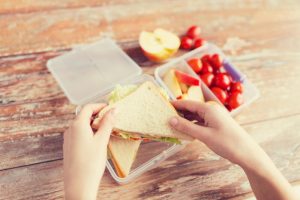
I wish I could say I grew up in one of those families that didn’t use cling wraps. However, as a kid, my sandwich was wrapped in plastic or put in a sandwich bag.
But the good news is, this is an easy change to start with. You simply put sandwiches straight into a container, no wrapping is needed.
My kids have always had school lunches this way, and it’s fine if you make lunches the night before, or freeze them.
The containers we use are plastic containers that we’ve had for years. As they’re in good condition, I don’t see the point in replacing them. But if we ever needed something different, I’d opt for containers that aren’t made from plastic, such as rice husk containers, which can be composted at the end of it’s life, or stainless steel, which can be recycled.
Alternately you can reuse takeaway containers for sandwiches. This is a particularly good idea, if your child is prone to loosing containers at school. So you can use these until their lunch container turns up in lost property, or in place of buying containers altogether.
Another alternative for to sandwiches is beeswax wraps.
Eco-friendly food storage
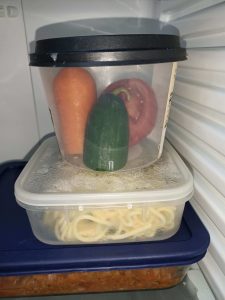
Reusable Containers
It’s likely you’ve already got containers you can use. I had many containers taking up space in the cupboard, so it’s good they’re put to better use now. Whatever you have is fine to use.
If you don’t have many containers, then start by looking at containers you’ve bought food in. I try to avoid plastic containers, designed for single-use, but if I do get them, they’ll be reused.
The intention of these ‘disposable’ food containers is to toss them after they’re emptied, but they’re sturdy enough to be refilled, many times. So if you have these containers, make the most of them.
Use a plate or bowl as a cover
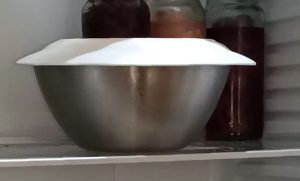
This is a great option for covering mixing or serving bowls, or for any leftovers you want kept on a plate, or in a bowl, in the fridge. It’s especially good when someone doesn’t finish, a meal, or if they get home late for dinner. I’ll also plate up leftovers, for future meals like this too.
An advantage of using a plate as a cover, in place of plastic wrap is that you can stack on top of it. So this helps to maximise fridge storage space.
Store in a saucepan
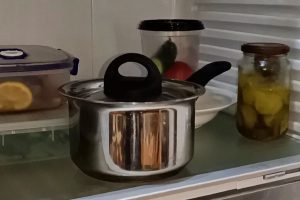
The advantage of storage in a saucepan is that you can save double handling with extra washing up. If I plan to reheat the food in the saucepan, then using the saucepan for storage, makes sense.
Sometimes I’ll do this if I cook ahead of time, then just reheat and serve. But you can also do this with leftovers in the pot too.
Note: Before you put the saucepan in the fridge, make sure you let it cool first.
Tea towels
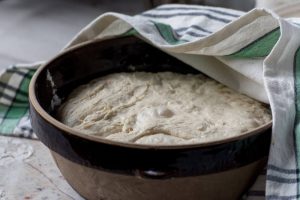
A very easy way to eliminate plastic wrap is to use the everyday tea towel. Ironically covering dough while it rises with a damp tea towel is not a new idea. It’s what was used before plastic, and now we’re going back to it, because it makes sense.
Many recipes suggest using cling wrap, but it doesn’t seem to offer any benefit to the dough.
You can also use tea towels to cover bowls to store food in the fridge, in place of plates, as suggested above. I find this method good for overnight or short term storage.
Reusable food covers
Some people use reusable wraps and covers, as their go to. But I only use them occasionally, for larger things that don’t suit containers, like cut watermelon or pumpkin.
Before buying any of these it’s best to consider what you’ll be storing, and how often they’ll be used.
If these look like something you’d like to try, I recommend you start with 1 or 2 covers to test them out. And only get more if you’re sure you’ll use them. Otherwise you’ll risk becoming a collector, and having a draw full of something you may not use.
Beeswax wraps

Beeswax wraps, are quite popular these days. You can buy them, or if you’re a little crafty, they’re easy to make. They’re made of 100% cotton fabric, beeswax and other ingredients such as coconut oil, or jojoba, and pine resin can be used in combination too.
You can use beeswax wraps as covers, or to wrap food. You can also get beeswax sandwich pocket or snack pouches, if you prefer a bag to a wrap.
To clean them, wipe with a warm cloth. If, you clean them at a hot temperature, it will melt the wax. Which is why it’s not recommended to use them for storing meats.
If you need to dispose of beeswax wraps, they can be composted.
Silicone food covers
There are pros and cons when comparing silicone to beeswax wraps. And you may prefer one or the other, or like me have some of each.
Silicone doesn’t break down like beeswax wraps, so they can’t be composted, and there are limited recycling programs for them, as council kerbside recycling doesn’t accept them. The recycling programs for silicone repurpose it for sports ground or road base. But they can’t be recycled back into another wrap.
But if they’re used for many years, then then that’s a lot of single use plastics that’s been avoided. So if you treat silicone as a purchase for life, then waste wise, you’ll be ahead.
Fitted silicone covers
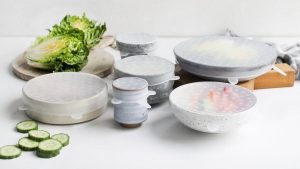
I’ve had silicon covers for many years, but they’re something I started using, more often, when I started to consciously avoid single-use plastics.
They come in different sizes, and are quite stretchy so you don’t need to be exact with the fitting. They can be used to cover half a cabbage or small melons too. If you invest in these, think about the sizes you’ll need or try a pack with different sizes to see if they suit you.
Silicone wraps
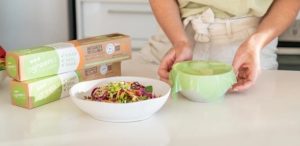
These are as close to cling wrap as you’ll get, in that you can see through them in the same way. Silicone wraps can be used in the same way as beeswax wraps, to wrap sandwiches or as covers on food.
The bonus with the silicone wrap is that because they can withstand high temperatures, you can also use them as a baking sheet, or as a cover in the oven instead of foil. They can also be used for covering meats too, as they can be washed in hot water.
The brand pictured is Agreena, and if you need to dispose of them, they’ll accept them back for recycling.
Fabric bowl covers
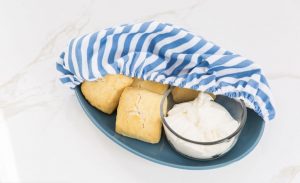
Fabric reusable food covers are another alternative to cling wrap, or in place of silicone and beeswax wraps. They’re typically fitted with elastic to hold them in place. And are machine washable.
But be aware that some covers have a polyurethane lining also known as a PU lining, which is a plastic coating to waterproof the fabric. Sometimes it’s referred to as a food safe lining. From a sustainability perspective, when disposed of they can’t be recycled if they have this plastic lining.
So while it may reduce single-use plastic, which is good, if you get the fabric covers without plastic lining, this is a more eco-friendly.
For an option that is more ‘zero waste’ look for quality linen or canvas. Ensure that if it’s lined that it’s plant derived, so they’ll be compostable, when they’ve done their time. So do some research, if you decide to go for these.
They also come in food pockets and wraps. You can check them out here.
Remember choose what works for you
There are many options to help you avoid cling wrap here, and you don’t need to use all of them. Have a look around and try what you think will work for you to, based on the way you store food. And remember every piece of single-use waste you can avoid, makes a difference.
If you’ve any other tips or some switches that work for you, I‘d love to hear them.



Awesome information! Thanks Kirsty, there’s certainly a lot of easy alternatives to cling wrap!
Thanks Sarah, and I know you’ve done great by ditching cling wrap in school lunch boxes.
I have made the switch in my house, my go to is bees wax wraps or glass containers.
That’s great Sally. It’s all about doing what works for you 🙂
If you’re after a reusable and non-toxic wrap that is also recyclable at the end of its life, you’re in luck! This Agreena 3-in-1 Wrap is made from the highest quality platinum silicone to create a food film that wraps, seals, and bakes. What I love about the Agreena Wrap is that it is incredibly versatile, whether you need an airtight cover for your leftovers or a tray liner for your day of baking, this eco-friendly wrap has you covered. Best of all, they’re made from 100% food-grade material, so no chemical nasties will ever be released into your food.
Really informative post. Really looking forward to read more. So many ways alternatives to cling wrap. There is no need to use it.
Great idea, we really need to stop using cling wrap. I avoid it whenever I can